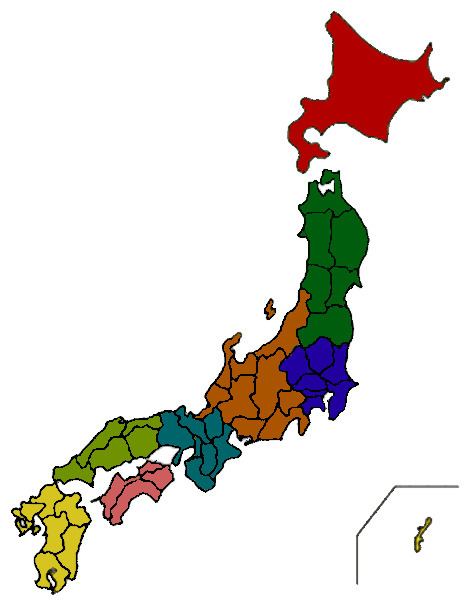The regions of Japan are not official administrative units, but have been traditionally used as the regional division of Japan in a number of contexts. For instance, maps and geography textbooks divide Japan into the eight regions, weather reports usually give the weather by region, and many businesses and institutions use their home region as part of their name (Kinki Nippon Railway, Chūgoku Bank, Tōhoku University, etc.). While Japan has eight High Courts, their jurisdictions do not correspond to the eight regions below.
From north to south, the traditional regions are:
Hokkaidō (the island of Hokkaidō and nearby islands, population: 5,507,456, largest city: Sapporo)
Tōhoku region (northern Honshū, population: 9,335,088, largest city: Sendai)
Kantō region (eastern Honshū, population: 42,607,376, largest city: Tokyo)
Nanpō Islands: part of Tokyo Metropolis
Chūbu region (central Honshū, including Mt. Fuji, population: 21,714,995, largest city: Nagoya), sometimes divided into:
Hokuriku region (northwestern Chūbu, largest city: Kanazawa)
Kōshin'etsu region (northeastern Chūbu, largest city: Niigata)
Tōkai region (southern Chūbu, largest city: Nagoya)
Kansai or Kinki region (west-central Honshū, including the old capital, Kyoto, population: 22,755,030, largest city: Osaka)
Chūgoku region (western Honshū, population: 7,561,899, largest city: Hiroshima)
Shikoku (island, population: 3,977,205, largest city: Matsuyama)
Kyūshū (island, population: 14,596,977, largest city: Fukuoka) which includes:
Northern Kyushu: Fukuoka, Saga, Nagasaki and Ōita
Southern Kyushu: Kumamoto, Miyazaki and Kagoshima
Okinawa
Each region contains several prefectures, except the Hokkaidō region, which covers only Hokkaidō.

